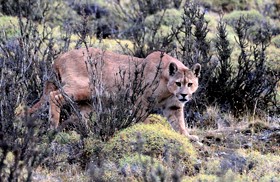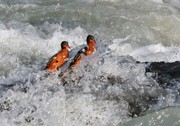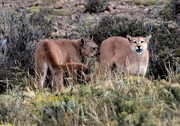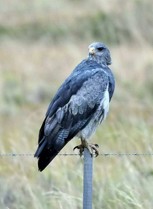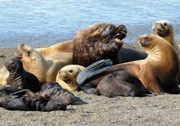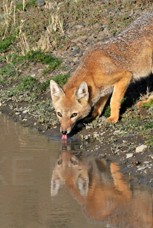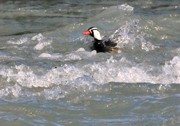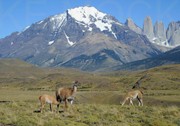Mike Mockler Patagonia - |
Below is Mike’s account of his recent trip to Patagonia with his wife, Pat: The highlight of our trip was Torres del Paine National Park in central Patagonia, somewhere I had wanted to visit ever since, more than 25 years ago, a friend who had worked there making a natural history radio programme told me it was a fabulous area. In fact, Torres del Paine was by far the most impressive place we saw on our tour. Some of the wildlife encounters we experienced there were among the most memorable we’ve had anywhere in the world. For a start, the landscape is ravishing. And, though the number of species is limited by the area’s southerly latitude, there is some remarkable wildlife there. We saw many special birds - some handsome ducks, attractive species of grebe including the gorgeous Great Grebe, Darwin’s Rhea, Upland Goose, Black-necked Swan, Black-faced Ibis, Chilean Flamingo, Cinereous Harrier and the powerful Black-chested Buzzard-Eagle. There is also the marvellous Torrent Duck, a species which spends much of its life in raging, white water and, of course, there is the magnificent Andean Condor too. The latter two species alone made our trip worthwhile as they provided unforgettable viewing and fabulous photographic opportunities. The most abundant mammal by far is the Guanaco, the wild ancestor of the domesticated Llama. Guanacos are the main prey of the local Pumas. There are two species of fox: Grey Fox and the handsome Red Fox (not the same as the European Red Fox). Both are fairly easy to see and to photograph. There are also two species of Armadillo, which I enjoyed watching and photographing. And there are some 40 Pumas in the area, which are very difficult to see, of course, unless you are very lucky. We saw three Pumas and enjoyed three absolutely unforgettable sessions with them at very close range. Inevitably, other parts of Patagonia could not match that. Furthermore, our visit to the Valdes Peninsula in eastern Patagonia was adversely affected by problems with the Aerolineas Argentinas flight we were supposed to take to reach there. Having been “bumped off” this flight and then informed that we would not be able to fly to Valdes the next day either, we ended up driving 1600 kms. to get there, thereby losing valuable time for finding wildlife. The Valdes Peninsula is famous for its Southern Right Whales, around which a significant whale-watching tourist industry has grown up, though our visit did not coincide with the time when the whales can be seen. In addition, for those who can remember David Attenborough’s BBC TV series “The Trials of Life”, Valdes is where Orcas sometimes hunt Sea-Lion pups on the shoreline and occasionally ground themselves on the shingle beaches. We hoped we might see Orcas but were unlucky. They are less reliable than the Southern Right Whales and, as a result of the flight problems described above, we had less time there than we needed to search for them. We briefly visited a few colonies of Sea-Lions and Southern Elephant Seals as well as a Magellanic Penguin rookery. However, we were kept a little way away from these colonies and usually could only view them from cliff-top level. Away from the coast, wildlife is rather limited – it’s the marine wildlife that brings people to Valdes. Even so, we did see a few Maras, the two species of Armadillo encountered at Torres del Paine and a few new birds. Western Patagonia, including Chiloe Island, was less fulfilling and, at times, very frustrating, with several tedious delays, some rainy weather and a lot of time spent driving. Nevertheless, the area did provide a very enjoyable boat trip when we saw a variety of seabirds, a colony of Southern Sea-Lions, a fairly distant group of Peale’s Dolphins and several Blue Whales, some at close range. The Blue Whales were wonderful, of course, though they rarely showed much of their body when surfacing. Only one showed us its fluke just a few inches above the surface. Other wildlife we saw well included a handful of land-birds, a few ducks and two Sea Otters. Finally, many thanks to Luis for looking after us so well!
Please note: Mike will be leading wildlife tours to Patagonia (including Torres del Paine National Park and the Valdes Peninsula) in 2012/13. For more details contact Mike direct or Antonia at The Ultimate Travel Company (go to Contact & Links)
More images from this trip can be found in Photographic Gallery>South/Central America>Patagonia
|
|
